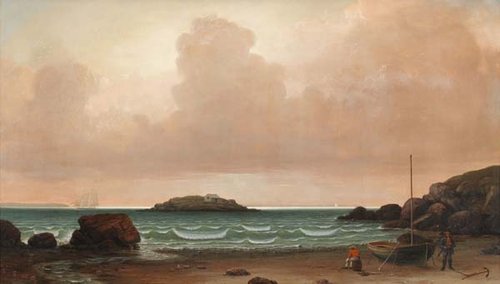The exterior of the Cape Ann Museum in Gloucester is all New England-traditional: granite posts, narrow clapboards, and stately brick. Step through the front door, however, and a contemporary space opens up before you—full of clean lines and washed in natural light.
The bright, open entryway is part of a recently completed, $3.5 million renovation that updated the space for the first time since the 1960s, says director Ronda Faloon. The museum reopened last week, after a 10-month closure.
“It was time for us to take care of the older portions of the building,” she says. “It’s made us better stewards of our collections.”
Set on an inconspicuous side street in downtown Gloucester, the Cape Ann Museum holds an unexpectedly rich trove of local art and artifacts, ranging from contemporary paintings to pewter dishware from the early 1800s. Though the collections may sometimes seem disparate and eclectic, they are united by a simple theme, says Faloon. “It’s a museum about place.
Among the most noticeable of the recent changes is the newly redesigned Fitz Henry Lane exhibit. The museum owns the world’s largest collection of art by the Gloucester native, renowned for his 19th-century maritime paintings. The gallery containing these works is now organized to guide visitors through the stages of Lane’s life, tracing the evolution of his art through the years.
One of the newest artifacts on display is also one of the most striking: A 10-foot-tall glass lens that topped one of the twin lighthouses on Rockport’s Thatcher Island more than 100 years ago. On permanent loan from the U.S. Coast Guard, the lens allowed the island’s warning light to be seen be ships as far as 22 miles from shore.
Even the coatroom and bathroom area received upgrades as part of the project. On the walls in this space, just off the entry area, local artist Diane KW created a custom installation featuring shards of blue and white pottery recovered from shipwrecks. The pieces are printed with words taken from the diaries of an 1830s sea captain and his wif
Faloon expects less noticeable changes will also make a substantial difference to visitors. The new climate control system will create a more comfortable environment for browsing the collections, she says, and newly installed lighting will give even repeat visitors a chance to better appreciate the familiar art.
“Even though people will be seeing a lot of the same works on the walls, they’ll be seeing them in a way they haven’t before,” Faloon says. “We’ve been able to tell the Cape Ann story in a better way, a more comprehensive way.”
The museum will be free and open to the public August 23 and 24, 10 a.m. to 5 p.m.
For more information visit http://www.capeannmuseum.org.

